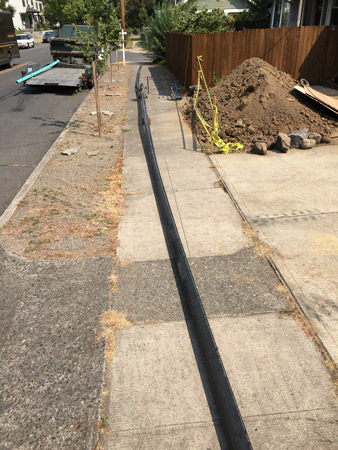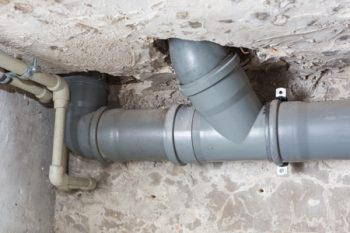Get Professional Directional Drilling in Portland Today!

Suppose you need a main water line installed, repaired, or replaced, but using traditional excavation methods is not ideal. In that case, you need our professional team at Superior Underground to handle all the drilling involved with the installation and repair of main water lines and sewage systems. Our local and dedicated team is here to make sure that your installations and repairs go smoothly with our state-of-the-art directional drilling services and equipment. This process allows us to install and maintain utilities without disturbing the ground that it crosses and only requires us to dig an entrance and exit hole at each end. Directional drilling allows our excavation specialists to work on your underground utility and sewer systems safely and efficiently. Call Superior Underground today and learn how we can use directional drilling equipment to help your home or business!
Horizontal Directional Drilling is Used for Many Projects
Our experienced team can utilize trenchless technology for many different projects, including:
- Main Water Lines
- Gas Lines
- Sewer Lines
- Electrical Conduits
- Driveway Sleeves
Why You Should Choose Directional Boring
This is an extremely useful method for congested areas, roadways, and environmentally sensitive areas around your home or business. We utilize these tried and true methods to complete projects within a timely manner and limit the amount of disturbance in any given area. Other benefits of horizontal directional drilling include the reduction of complete construction time, the mess made, cleaning up afterward, less impact on the surrounding areas, little to no need for traffic disruptions, and an overall reduced cost for long-term piping. With our professional team, we can solve your residential or commercial plumbing issues quickly and efficiently. Call Superior Underground today to learn more about our directional drilling services!
Stop Searching for Directional Drilling Near Me, Call Superior Underground Today!
 Laying underground pipes has never been easier. At Superior Underground in Portland, we offer excellent directional drilling services, specializing in minimal disruption to environmentally sensitive areas. Our trenchless methods make sure that existing utilities remain intact, making us the smart choice for any project in need of precision and efficiency. Whether you’re a residential or commercial customer, we guarantee satisfaction by delivering on-time, cost-effective solutions that pave the way for a seamless transition to the next project. With our commitment to quality and innovation, clients can trust our technicians at Superior Underground to exceed expectations and uphold the highest standards in boring services.
Laying underground pipes has never been easier. At Superior Underground in Portland, we offer excellent directional drilling services, specializing in minimal disruption to environmentally sensitive areas. Our trenchless methods make sure that existing utilities remain intact, making us the smart choice for any project in need of precision and efficiency. Whether you’re a residential or commercial customer, we guarantee satisfaction by delivering on-time, cost-effective solutions that pave the way for a seamless transition to the next project. With our commitment to quality and innovation, clients can trust our technicians at Superior Underground to exceed expectations and uphold the highest standards in boring services.
Call or contact us today to get started!
FAQs About Directional Drilling
Directional drilling, also known as horizontal drilling or directional boring, is a technique used in the oil and gas industry, as well as other industries, to drill wells or boreholes that deviate from the vertical plane. It allows for the drilling of wells at various angles and directions, enabling access to reservoirs or resources that are located beneath obstacles, sensitive areas, or otherwise difficult-to-reach locations.
Oil and Gas Exploration: In the oil and gas industry, directional drilling is employed to reach oil and gas reserves located beneath urban areas, bodies of water, or environmentally sensitive regions.
Resource Extraction: Directional drilling is used to access underground resources such as minerals, water, or geothermal energy in areas where traditional vertical drilling may not be feasible.
Utility Installation: It is used to install utility lines, such as pipelines, electrical conduits, and fiber optic cables, under roads, rivers, or existing infrastructure without disruptive excavation.
Environmental Protection: Directional drilling minimizes surface disruption and reduces the impact on the environment, making it a preferred method for certain projects.
Landfill Drilling: It is used to access and extract methane gas from landfills for energy generation.
The depth to which directional drilling can go depends on several factors, including the technology used, the geological conditions, and the specific project’s requirements. In the oil and gas industry, directional drilling can reach impressive depths, with some wells extending several kilometers into the Earth’s crust.
For example, in the oil and gas sector, directional drilling has been used to drill offshore wells that reach depths of more than 10 kilometers (over 6 miles). In other applications, such as environmental drilling or utility installation, the depth may be much shallower, typically ranging from a few hundred meters to a kilometer.
The continuous advancement of drilling technology and equipment has allowed for deeper and more complex directional drilling projects, making it possible to access previously inaccessible resources and reservoirs deep underground.
Directional drilling methods involve using specialized drilling equipment and technologies to control the direction and trajectory of the borehole. Some common directional drilling methods include:
Slant Drilling: Involves drilling a well at a predetermined angle from the vertical plane. The angle can vary based on the project’s requirements.
Horizontal Drilling: This method is used to drill a well horizontally once the desired depth is reached, allowing access to a larger area of the reservoir or resource.
Multilateral Drilling: Involves branching off from an existing wellbore to drill multiple lateral wells, further maximizing access to resources.
Directional Re-Entry: Utilizes existing wellbores as entry points to drill new wells in a different direction.
Whipstock Method: Involves using a wedge-shaped tool called a whipstock to deflect the drill bit’s direction, allowing drilling in a new direction from the original wellbore.
Magnetic Guidance Systems: Utilizes magnetic survey tools to navigate and control the drill bit’s path in the desired direction.
Each method has its advantages and is chosen based on the specific geological and operational requirements of the project.
